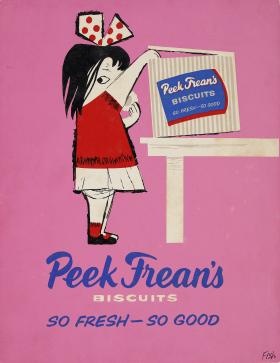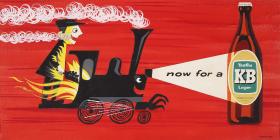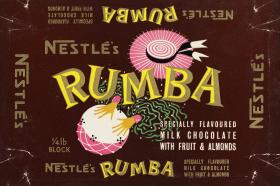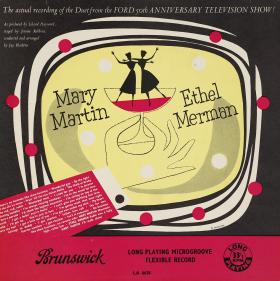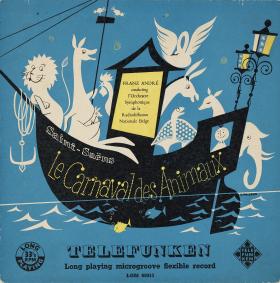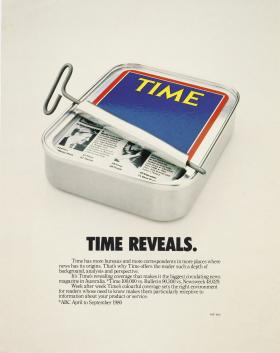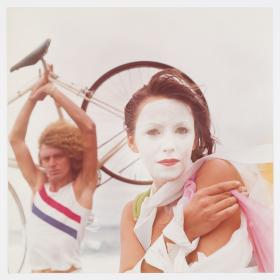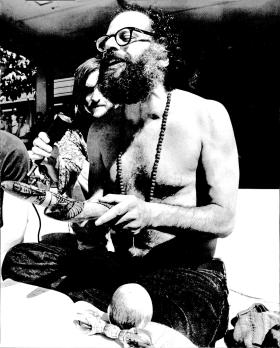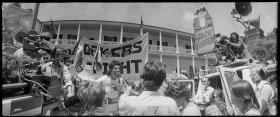They called her Myrtle. The little girl stands before a hot pink backdrop, hair askew, a hand in a Peek Frean’s biscuit tin. Plucky yet furtive, she’s looking to the side, one beady eye alert to the chance she might be caught with her hand in the cookie jar. Underneath this drawing of a mischievous theft are the words ‘Peek Frean’s Biscuits So Fresh — So Good’. The British biscuit company’s ad, cheeky and bright, won the Outdoor Advertising Association of Australia’s Poster of the Year award in 1956.
This poster is just one example of the mid-century, sometimes child-like, always optimistic humour to be found in the extensive Donald Fish archive held by the State Library. Fish, a graphic designer whose career spanned 60 years, often added a human or anthropomorphised animal element to his designs, stylised as bold cartoon characters, in advertisements that ranged from baby powder to beer. Vibrant colours and playful styles were, in fact, the antithesis of Australian ads of the era, which typically featured white backgrounds crammed with words, or photo-realist portrayals of suburban life.
The work of this polymath, graphic designer, illustrator, writer and cartoonist who died, aged 92, in 2021, deserves to stand alongside that of the world’s best graphic designers — Saul Bass, Paul Rand, Milton Glaser — as well as the man who most influenced Fish’s work, Raymond Savignac. This celebrated French poster artist used bright colours and characters to not only pique interest, but to instil a feeling of happiness in his target audience. He defined poster art as ‘the creation of a fleeting image which people will not forget’.
A young Donald Fish travelled to Europe in the 1950s to learn to draw in the style of this poster artist and indeed met Savignac in Paris. Within the archives is a photo of a smiling, besuited Fish standing in front of the Eiffel Tower, balloons in the background. The caption on the back reads, ‘while visiting Paris 1953 studying poster design’.
Born in 1929, Donald Fish grew up in the Sydney suburb of Vaucluse and, by his own admission, had an idyllic and creative childhood. ‘I was intrigued by design for as long as I can remember,’ he said in a 2009 interview. ‘My peers used to surround me at school while I drew humorous little sketches and giant mandalas.’
Fish began his career as a message boy at Lintas advertising agency and, by age 20, was promoted to the creative department. He soon moved to London to work at the London Press Exchange. According to the biography written for the Powerhouse Design Hub and now on the Australian graphic design website Re:collection, it was here that Fish created posters for clients such as Cadbury’s and National Benzole.
He also worked on many record covers, now held in the Library’s collection, which also holds copies of magazine interviews and press clippings, chocolate tins, matchboxes and original artwork. He returned to Australia in 1954, a time of optimism and creativity both for Fish and like-minded colleagues. He began working with clients such as P&O, Qantas, Reschs, and Schweppes. His work appeared in prestigious international design publications such as Graphis and Modern Publicity. He recalled later, ‘In the fifties, writers and artists would meet at various places like my [Phillip Street] studio, and other haunts such as Lorenzini’s Coffee Lounge, Vadim’s and The Lincoln. People working in the arts would meet, talk, argue and carouse until the early hours of the morning.’
Donald Fish’s work in the 1950s reflects the aesthetic we know as midcentury modern. Among the ephemera in the archive are confectionary labels for Coconut Rough and Rumba from 1955. Their colours are bold and timeless: palm tree patterns in green and blue, a Cuban musician playing a conga in bright pink, green and yellow. There are also chocolate and biscuit tins and boxes: on the Nestlé’s Variety chocolate box, each letter of ‘Variety’ is different — upper case, lower case, variations in colour and font — illustrating that inside lies a tantalising array.
Within the collection is a typed essay, ‘The Poster: Advertising’s Poor Cousin’, where Fish questions why the poster had remained an anachronism given the sophisticated thinking devoted to other media. He argued that the poster has a lifestyle all its own, and a unique function. He reflected on his own craft: ‘Conceiving a poster is exciting because it’s one hell of a challenge. To penetrate, a poster must pack an emotional and visual wallop. It can shock, it can be hilarious. A poster must shatter the norm to gain attention.’ He encouraged boldness, saying, ‘the cardinal sin is modesty’.
His essay, a highly edited version of which was published in B&T Weekly, offers insights into the thinking behind advertising, where art and commerce meet. He writes that it all begins with an idea: ‘[Posters] are there to communicate, and if they’re well-conceived and exciting they can stimulate us, brighten our days and shift merchandise … The poster is to advertising what the string quartet is to music.’
These days, commercial posters are revered as art objects and can command thousands at auction. Mid-century graphic design holds an exalted position; the poster has been taken off the street and displayed on gallery walls. Vintage posters are both art and commerce, used to sell a product or service. They hold nostalgic value too, part of collective memory and shared visual lexicon.
In Donald Fish’s hands, even the driest subject could be imbued with excitement. The collection includes immaculate copies of the Commonwealth Bank annual report from 1957. The cover features an illustrated hand holding a fountain pen in cufflinked shirt and jacket sleeve, surrounded by numbers in purples, greens, black and red. A clipping from the Sydney Morning Herald reads: ‘Once again the Commonwealth Trading Bank has produced one of the gayest and most colourful annual reports in the country. Queer to think of a bank report as being gay but it is, thanks to the clever, original designs by Mr Donald Fish.’ His design won a medal from the Australian Commercial & Industrial Artists Association.
Fish and his art director wife, Victoria, met in 1961 and travelled the world together, including a second stint in London. Returning to Sydney in the mid-1960s, the couple and their friend Grant Roberts started a new side venture. Inspired by vintage shops in Chelsea and Knightsbridge, the trio opened a shop called Kaleidoscope on the corner of John and Moncur Streets, Woollahra. Full of antique oddities, it had a giant K out the front, a remnant from the 1883 Marcus Clark Furniture and Drapery store. A note in the archive in Donald Fish’s hand writes that the shop was ‘very famous for selling outlandish wares’.
Kaleidoscope hosted an ‘opening’ once a month, similar to a gallery event, with bonhomie and drinks. At the first one, according to The Australian columnist Daphne Guinness, actress Bunney Brooke bought a pile of beaded clothes and a ‘man’s black velvet waistcoat last seen in a flea market in Paris’. Guinness wrote that Don and Vicky Fish, with Roberts, were ‘trying to inject into Australian antique shopping some of the fun they found in London markets’.
A black and white photograph from 1967 shows Liza Minnelli peering into the window. So taken with Kaleidoscope was the entertainer that she filmed part of a TV special there. Alongside footage of her singing siren songs at Chequers nightclub, and a love song in front of images of herself with Peter Allen — who she wed that year — there’s a scene where the singer belts out ‘Along the Road to Gundagai’ while browsing the store.
In one of the archive boxes is a sticker, and a hot pink handbill shaped like a long bookmark, declaring that the store stocked ‘a dazzling array of goodies … including a wooden butter churn, a diplomatic frock coat, a pair of bellows and a black Ginger Rogers dance dress with gold lamé stripes by Selma Keane of New York, one of those rather awful Victorian frilly glass lamps, a feather boa, a stuffed pheasant and a painting of a spectacularly ugly lady standing among leaves’.
In the late 1960s, Donald Fish became the creative director of an American ad agency, working on award-winning campaigns with the likes of British Airways. He then started his own agency, Fountain Huie Fish, working with clients including Qantas, Club Med and Lufthansa. Numerous flyers, brochures and posters reflect what seems now to be a golden age of air travel.
In 1975, promoter Harry M Miller called Donald Fish asking him to work on a campaign to promote the stage musical Jesus Christ Superstar. Fish recalled that he had little to draw on for the poster design, other than photographs of the cast taken during rehearsals. His solution? He would blow up two small portraits to create a dramatic effect of good versus evil with Jon English, who played Judas, in red, and Trevor White, who played Jesus, in white. The image was even reproduced on matchboxes.
Three typed pages list the many awards Donald Fish received over his career, perhaps the most prestigious being the 1981 Clio Award for the Time magazine international campaign he designed and directed. Across the campaign is a blue and red magazine cover; one poster reads ‘Time Reveals’, and the cover is depicted as a can of sardines unfurling. For ‘Time Elevates’, a man is standing in an ascending lift, the doors, made from a Time magazine cover, opening. For ‘Time Flies’, there’s a magazine cover on the tail of a plane.
No doubt his 2011 induction into the Design Institute of Australia Hall of Fame was another career highlight.
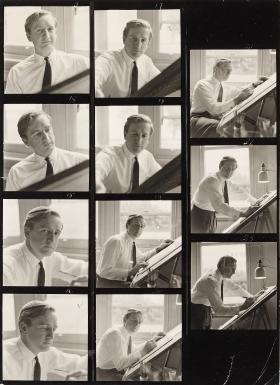
Andrea Black is a Sydney-based freelance writer.
This story appears in Openbook autumn 2022.
View a selection of graphic designs by Donald Fish on display in the Amaze Gallery.

